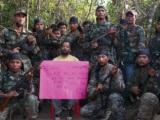Archives
Mushrooming of Militant Outfits in Achikland
Though the Achikland is rich in minerals such as coal, most of the mining is done by people from outside the State, thereby depriving the Achiks of the benefits. The tourism industry has also not reached the expected mark in spite of the region having ample scope to develop places of interest and heritage sites. It is therefore an irony that the National Balpakram Sanctuary, the Siju caves and other such sites now exist as mere showpieces and in most cases, lack even proper connectivity. A case in point is that people from the Garo Hills areas, in order to reach the State capital Shillong, have to travel through Assam. Such is the sorry state of affairs for the people of this region.
| Any peace talks with these outfits are therefore overshadowed especially by the fact that no progress is being made towards an acceptable solution. |
Achikland also shares an international boundary with neighbouring Bangladesh in the south, the border area being porous, thus inviting illegal influx has threatened to overrun the indigenous population reducing this to a minority, especially in the plains areas of Garo Hills. People also suffer from the ravages of floods especially during the monsoon season which affects agricultural activities thus forcing the population into abject poverty. In light of the separation from the State capital, it can be surmised that Shillong is simply too far away to address the  problems faced by the people of this area. All these factors, over the years, have become seeds of discontent which have today led the youth of this area on to the path of militancy and to rebel against the many lapses of the Government administration and machinery.
problems faced by the people of this area. All these factors, over the years, have become seeds of discontent which have today led the youth of this area on to the path of militancy and to rebel against the many lapses of the Government administration and machinery.
The first sign of militancy was witnessed way back in 1993 as a show of discontent to the political leadership which could not address the various problems and difficulties faced by the people of the area at that point of time. It was then that the ALMA outfit had surfaced which later became the Achik National Volunteer Council (ANVC). This militant group had put up a demand for a separate Achikland or Garo State which would include the Garo dominated areas of Kamrup and Goalpara districts of Assam. This outfit had backed up its demand with violent and subversive activities which the administration was not able to tackle and thereby nip in the bud.
Efforts to settle the demand of the ANVC however yielded results as a ceasefire agreement was arrived at with the Union Government along with the State Government. These talks however, did not yield any additional positive results apart from this ceasefire and were kept hanging fire.
During the lingering period, the ANVC leadership and cadre became restless and a section of the ANVC broke away from the main group forming the ANVC (B). This splinter group later also  entered into talks with the State Government with the watering down of the demand for a separate State into a Garoland Autonomous Council. The talks that followed however, could not make any headway and this further splintered the group and led to the formation of the United Achik Liberation Army (UALA) which became more violent and daring in nature, resorting to brazen acts of violence including the attack on the Williamnagar jail on the 2nd of February 2013. This incident was truly shocking as three jailors were dragged out and shot to death in cold blood. The militant outfits continue to mushroom in the area, indulging in murder, extortion from the coal traders and businessmen there where even small time traders are not spared. The militants of the outfit have become so bold that they, from time to time, casually walk about in full military uniform in market places and intimidate the traders there, especially the non – Garos. In a recent incident, over a dozen suspected militants trooped into a village market in Tikrikilla and abducted three non – tribal traders at gun point in broad daylight. These petty merchants were dealing in general merchandise and were also exporting the ginger grown in the Garo Hills to markets in Assam. These militants have also established routes to market places in neighbouring Assam.
entered into talks with the State Government with the watering down of the demand for a separate State into a Garoland Autonomous Council. The talks that followed however, could not make any headway and this further splintered the group and led to the formation of the United Achik Liberation Army (UALA) which became more violent and daring in nature, resorting to brazen acts of violence including the attack on the Williamnagar jail on the 2nd of February 2013. This incident was truly shocking as three jailors were dragged out and shot to death in cold blood. The militant outfits continue to mushroom in the area, indulging in murder, extortion from the coal traders and businessmen there where even small time traders are not spared. The militants of the outfit have become so bold that they, from time to time, casually walk about in full military uniform in market places and intimidate the traders there, especially the non – Garos. In a recent incident, over a dozen suspected militants trooped into a village market in Tikrikilla and abducted three non – tribal traders at gun point in broad daylight. These petty merchants were dealing in general merchandise and were also exporting the ginger grown in the Garo Hills to markets in Assam. These militants have also established routes to market places in neighbouring Assam.
Another militant outfit is the Achik National Liberation Army (ANLA) which made its presence felt just recently in October last. Its Commander – in – Chief Tengsang Achik had issued diktats to political leaders and public representatives demanding accountability and implementation of development work. Other groups that have surfaced in the area are the Achik National Security Force (ANSF) and also the GNLA (F) which have driven the situation in the Garo Hills from bad to worse.
| People from the Garo Hills areas, in order to reach the State capital Shillong, have to travel through Assam. Such is the sorry state of affairs for the people of this region. |
The Garo National Liberation Army (GNLA) seems to be taking the lead in the continuing of violent activities in the area. This outfit was formed in 2009 by a police deserter Pakchara R Sangma who is better known by the name of Champion Sangma and also by Sohan D Shira who is known to be the outfit’s Commander – In – Chief. In a major breakthrough, Champion Sangma was arrested by police personnel on the 31st of July 2012 after he was reportedly detained in neighbouring Bangladesh. Though the events which led to his arrest are murky at best, this breakthrough was celebrated as a back – breaking loss for the militant outfit. However, it was soon revealed that the main cog in the GNLA machinery is not Champion Sangma, rather, it is the outfit’s Commander – in – Chief Sohan D Shira who really runs the show. The celebrations of the State Government and police personnel were short lived as, soon after Champion’s arrest, the violent activities of the outfit picked up in right earnest. This upsurge in activities was taken as the outfit’s show of strength and its ability to operate without its Chief by the authorities but with no abatement in the incidence of violence, the latter had to concede that Champion’s arrest was not the killing blow to the outfit as it was perceived. Apart from civilians, GNLA cadre have also attacked policemen and paramilitary force personnel including the Border Security Force (BSF). Five policemen had fallen to a fusillade of bullets in an ambush at Bahgjakona while they were travelling in a vehicle. On Diwali day, as many as eleven people belonging to the Rabha community were killed on the Assam side of the border which raised fears of an ensuing ethnic clash. There are also reports that the GNLA is extending its activities and has ventured into the neighbouring West Khasi Hills district especially in the coal mine belt areas there.
 The recent upsurge in the formation of militant groups is not exactly for any ideology or political demands but the strong motive behind it all is to make easy money through looting for the purpose of enhancing the outfit’s military capabilities and also to fill up personal coffers. Sohan Shira, for instance is believed to have amassed money to the tune of rupees twenty crores. This motive behind the activities of GNLA has been subscribed to by none other than IGP (Operations) of Police GHP Raju who was at one point of time in direct control of anti – GNLA operations of the Meghalaya Police in Garo Hills. It is therefore apparent that militants are now functioning like corporations in Meghalaya and are inclined to make money by any means including violence and intimidation.
The recent upsurge in the formation of militant groups is not exactly for any ideology or political demands but the strong motive behind it all is to make easy money through looting for the purpose of enhancing the outfit’s military capabilities and also to fill up personal coffers. Sohan Shira, for instance is believed to have amassed money to the tune of rupees twenty crores. This motive behind the activities of GNLA has been subscribed to by none other than IGP (Operations) of Police GHP Raju who was at one point of time in direct control of anti – GNLA operations of the Meghalaya Police in Garo Hills. It is therefore apparent that militants are now functioning like corporations in Meghalaya and are inclined to make money by any means including violence and intimidation.
Any peace talks with these outfits are therefore overshadowed especially by the fact that no progress is being made towards an acceptable solution. The State Government, instead would come down with a heavy hand when the Inspector General of Police in charge of Administration and Operations had vowed that the GNLA would be neutralised within three months in spite of limitations, manpower and training which would have enhanced the fighting capabilities of the police personnel in the hostile terrain where the GNLA is believed o have set up its bases.
In light of all this, as far as Achikland is concerned, there seems to be no silver lining in the horizon, at least in the near future.

